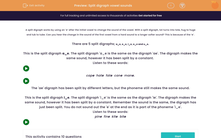A split digraph works by using an ‘e’ after the initial vowel to change the sound of the vowel. With a split digraph, tot turns into tote, hug to huge and tub to tube.
Can you hear the change in the sound of the first vowel from a short sound to a longer sound? This is because of the ‘e’. This magic 'e' makes the vowel say its own name!

There are five split digraphs:
a_e
e_e
i_e
o_e
u_e
This is the split digraph a_e. The split digraph 'a_e is the same as the digraph 'ae'. The digraph makes the same sound, however it has been split by a consonant.
Listen to these words:
cape hate fate cane mane
The 'ae' digraph has been split by different letters, but the phoneme still makes the same sound.

This is the split digraph i_e. The split digraph 'i_e' is the same as the digraph 'ie'. The digraph makes the same sound, however it has been split by a consonant. Remember that the sound is the same, the digraph has just been split. You do not sound out the 'e' at the end as it is part of the phoneme 'i_e'.
Listen to these words:
pine fine kite bite
.jpg)







